
Browse an alphabetical list of photographs. These historical images portray people, places, and events before, during, and after World War II and the Holocaust.
<< Previous | Displaying results 2601-2641 of 2641 for "Photo" | Next >>
Wladislava Karolewska, a victim of medical experiments at the Ravensbrück camp, was one of four Polish women who appeared as prosecution witnesses at the Doctors Trial. Nuremberg, Germany, December 22, 1946.
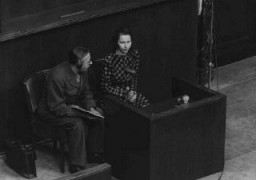
Women prisoners standing in front of barracks at the Gurs camp. Gurs, France, ca. 1943.
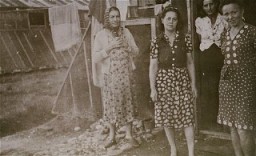
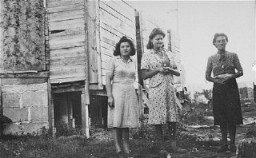
Women prisoners lie on thin mattresses on the floor of a barracks in the women's camp in the Theresienstadt ghetto. Czechoslovakia, between 1941 and 1945.

Women survivors huddled in a prisoner barracks shortly after Soviet forces liberated the Auschwitz camp. Auschwitz, Poland, 1945.
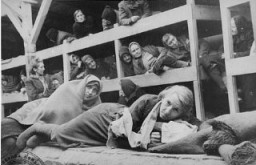
A crowd stands outside of a polling center in Berlin during the German national election in January 1919. This was the first election held under the Weimar Republic (1918–1933), as well as the first election in which women had the legal right to vote in Germany. Women's suffrage was declared in Germany only a couple of months earlier, on November 12, 1918. © IWM Q 110868
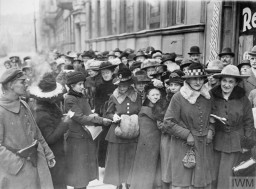
The armistice that ended the hostilities of World War I was signed in a railcar in the Forest of Compiègne. The railcar belonged to French Marshal Ferdinand Foch, the commander of the victorious Allied forces. © IWM Q 61172
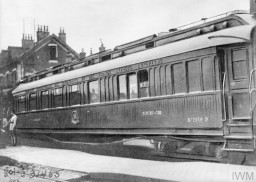
This 1919 photograph shows destruction in the leading business thoroughfare of Rheims after bombardment during World War I. Rheims, France, 1919.
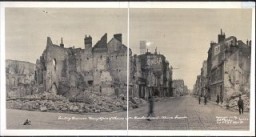
A man, women and a child sort through the rubble of a Polish home destroyed during World War I. Photograph taken ca. October 18, 1915.
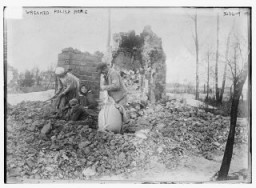
This 1919 photograph shows World War I destruction in Ypres, Belgium.
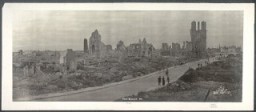
Ruins of the library in Louvain, destroyed during World War I. Louvain, Belgium, ca. 1914–1915

Scene of trench warfare: an abandoned British trench which was captured by German forces during World War I. German soldiers on horseback view the scene.
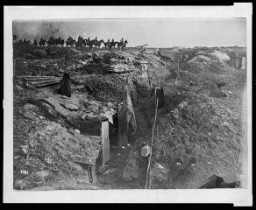
A US army field hospital inside the ruins of a church in France during World War I. France, 1918
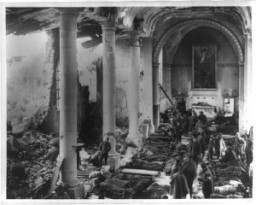
Wounded Soviet prisoners of war. The German army provided only minimal treatment, and permitted captured Soviet personnel to care for their own wounded using only captured medical supplies. Baranovichi, Poland, wartime.
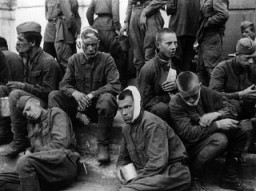
Wounded Soviet prisoners of war await medical attention. The German army provided only minimal treatment, and permitted captured Soviet personnel to care for their own wounded using only captured medical supplies. Baranovichi, Poland, wartime.
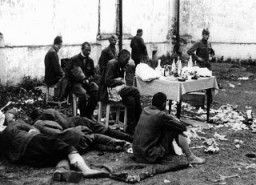
In front of the German consulate building, writers demonstrate against Nazi book burnings. New York, United States, May 10, 1938.

Xaver Franz Stuetzinger, a member of the Communist Party of Germany, was tortured by the SS at the Dachau concentration camp. He died in May 1935 without divulging his connections. Germany, before May 1935.
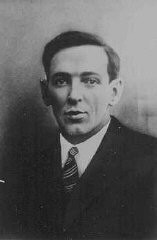
Soviet photographer Yevgeny Khaldei stands on top of the Brandenburg Gate in Berlin where he, along with a few Soviet soldiers, raised the Soviet flag. Berlin, Germany, May 1945.
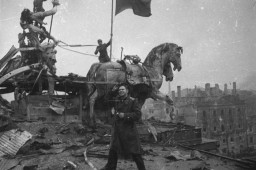
Soviet photographer Yevgeny Khaldei views the destruction of Budapest from a rooftop. Budapest, Hungary, February 1945.
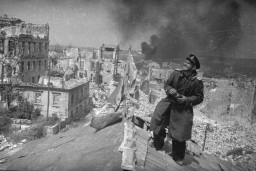
Photograph of Yisrael and Zelig Jacob, the younger brothers of Lili Jacob, from the Auschwitz Album.
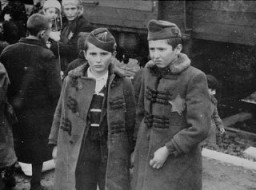
Yitzhak (Antek) Zuckerman, Zionist youth leader and a founder of the Jewish Fighting Organization (ZOB). He fought in the Warsaw ghetto uprising. Place and date uncertain.

Yitzhak Gitterman (left), Joint Distribution Committee (JDC) director in Warsaw, meets with the representative of an Orthodox Jewish organization. Warsaw, Poland, date uncertain.
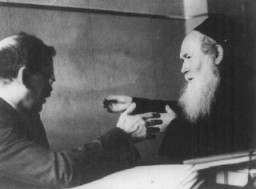
Yitzhak Rochzyn (other spellings: Isaac Roszczyn and Icchak Rochczyn) youth group leader and leader of the Lachwa ghetto underground.
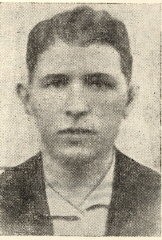
The "You Are My Witnesses" wall in the Hall of Witness at the United States Holocaust Memorial Museum. Washington, DC, January 2003.
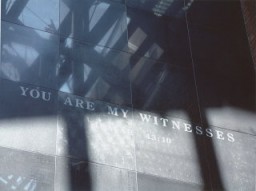
Elementary school-age members of Hashomer Hatzair in the Stuttgart displaced persons camp, circa 1946–1949. Lova Warszawczyk is standing in the center.
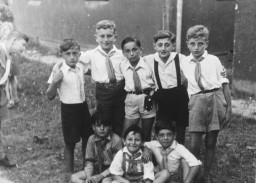
A group of young girls poses in a yard in the town of Ejszyszki (Eishyshok). The Jews of this shtetl were murdered by the Einsatzgruppen on September 21, 1941. Photo taken before September 1941.
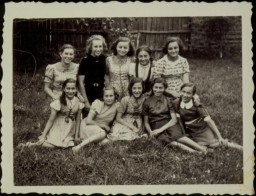
A brother and sisters, members of a Jewish family. One of the sisters pictured here, along with other family members, did not survive the Holocaust. Nove Zamky, Czechoslovakia, May 1944.
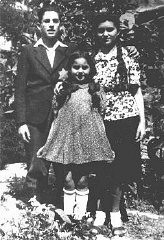
This photograph taken soon after liberation shows young camp survivors from Buchenwald's "Children's Block 66"—a special barracks for children. Germany, after April 11, 1945.
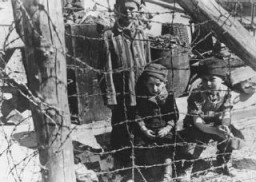
Young survivors of the Buchenwald concentration camp soon after liberation. Germany, April-June 1945.
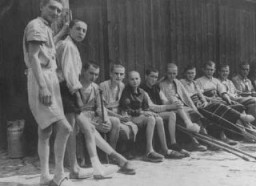
Children in the Bad Reichenhall displaced persons camp. Germany, 1945.
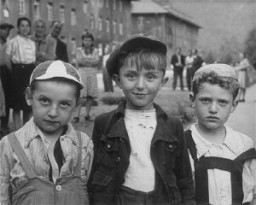
The Kloster Indersdorft displaced persons camp opened in July 1945. By mid-September, 1945, 192 boys and girls from thirteen nations, including 49 Jewish children, were sheltered at Kloster Indersdorf, more than double what had been anticipated. Over the next year, the numbers increased to over 300. Five hours each day were allocated to education. Teachers were drawn from the staff as well as the local community. Many of the children had few or no literacy skills; they also benefitted from art, music,…
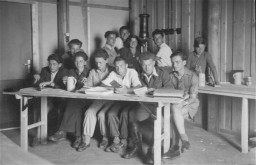
Youths with camp numbers tattooed on their arms aboard Aliyah Bet ("illegal" immigration) ship Mataroa, at the Haifa port. They were denied entry and were deported to Cyprus detention camps. Palestine, July 15, 1945.
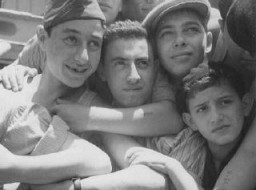
Mr. Mandil and his son Gavra, Yugoslav Jews, while in hiding. The Mandil family escaped to Albania in 1942. After the German occupation in 1943, Mandil's Albanian apprentice hid the family, all of whom survived. Albania, between 1942 and 1945.
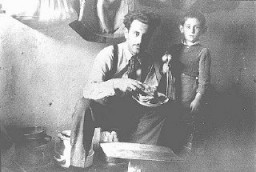
Yugoslav partisan leaders Josip Broz Tito (left) and Mosa Pijade (right). Pijade was a Jewish partisan with the Communist resistance. Yugoslavia, between 1941 and 1944.

View of the Zeilsheim displaced persons camp. Zeilsheim, Germany, 1945.
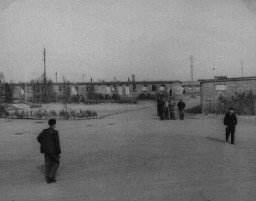
Prewar portrait of mother and son Zeni and Rudy Farbenblum. Munkacs, 1922.
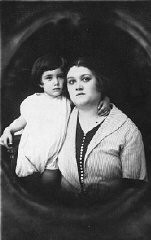
Zivia Lubetkin, a founder of the Jewish Fighting Organization (ZOB) and participant in the Warsaw ghetto uprising. Poland, date uncertain.
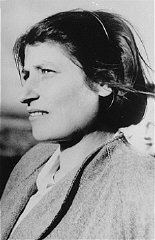
Witness Zivia Lubetkin Zuckerman testifies during the trial of Adolf Eichmann. Jerusalem, Israel. May 3, 1961.
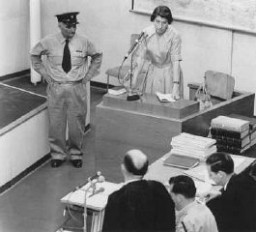
Zsofi Brunn and members of her family were deported from Hungary to Auschwitz-Birkenau in June 1944. Her husband and mother were killed upon arrival. Zsofi and her daughter Anna were transferred to a labor camp in Czechosovakia. They were eventually liberated by Soviet forces in May 1945. Zsofi and Anna returned to Hungary. They moved to Rakosszentmihaly, near Budapest. There, Anna finished high school, and Zsofi directed a Jewish orphanage. This photo shows Zsofi (back row, center) posing with the…
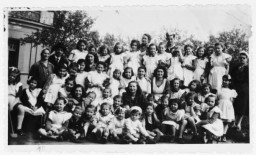
Zvi Ben-Yaakov (left) and Haviva Reik (center), Jewish parachutists under British command. Their mission was to aid the Jews in Czechoslovakia, where they were caught by the Nazis and executed. Palestine, before September 1944.
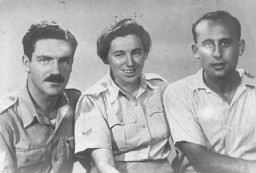
Zyklon B pellets found at the liberation of the Majdanek camp. Poland, after July 1944.

We would like to thank Crown Family Philanthropies, Abe and Ida Cooper Foundation, the Claims Conference, EVZ, and BMF for supporting the ongoing work to create content and resources for the Holocaust Encyclopedia. View the list of donor acknowledgement.